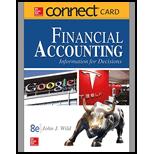
Concept explainers
Provide the names of two (a) asset accounts, (b) liability accounts, and (c) equity accounts.
Concept Introduction:
Assets are physical as well as intangible resources of the business which are kept forproviding future economic benefits.Liabilities are dues or amount payable by the business. Equity represents the sum of capital and profits/ loss earned by the business owners. Net asset is the amount of assets available after payment of liabilities.
To indicate: The names of two assets, two liabilities, and two equity accounts.
Explanation of Solution
Assets: Assets are physical as well as intangible resources of the business which are kept providing future economic benefits. The names of two assets accounts are as follows:
- Equipment: Equipment is an asset purchased for production.
- Land: Land is a long term asset.
Concept Introduction:
Assets are physical as well as intangible resources of the business which are kept for providing future economic benefits. Liabilities are dues or amount payable by the business. Equity represents the sum of capital and profits/ loss earned by the business owners. Net asset is the amount of assets available after payment of liabilities.
To indicate: The names of two assets, two liabilities, and two equity accounts.
Explanation of Solution
Liabilities: Liabilities are dues or amount payable by the business. The names of two liabilities accounts are as follows:
- Accounts payable: Accounts payable is a short term liabilities for payment of purchases.
- Long term loan: Long term loan is a long term liability for payment of loan.
Concept Introduction:
Assets are physical as well as intangible resources of the business which are kept for providing future economic benefits. Liabilities are dues or amount payable by the business. Equity represents the sum of capital and profits/ loss earned by the business owners. Net asset is the amount of assets available after payment of liabilities.
To indicate: The names of two assets, two liabilities, and two equity accounts.
Explanation of Solution
Equity: Equity represents the sum of capital and profits/ loss earned by the business owners.
Net assets: A net asset is the amount of assets available after the payment of liabilities. The names of two equity accounts are as follows:
- Common stock: Common stock represents the amount of investment made by the business owners.
- Retained earnings: Retained earnings represent the accumulated net income of the business.
Want to see more full solutions like this?
Chapter 2 Solutions
Connect Access Card for Financial Accounting: Information and Decisions
- What was the balance in retained Earnings at December 31 2023 ?arrow_forwardA change in accounting estimate affects? A. Prior periods only B. All periods equally C. Current period only D. Current and future periods MCQarrow_forwardCan you solve this financial accounting problem using accurate calculation methods?arrow_forward
- I need guidance with this financial accounting problem using the right financial principles.arrow_forwardPlease explain the solution to this general accounting problem with accurate explanations.arrow_forwardCan you solve this general accounting problem with appropriate steps and explanations?arrow_forward
- Can you explain the correct methodology to solve this financial accounting problem?arrow_forwardPlease provide the solution to this financial accounting question using proper accounting principles.arrow_forwardJK Corporation is finishing its fifth year in business with a gross income of $780,000 and total deductions of $420,000. In the second year, the company had a net loss of $125,000, and in the fourth year, it had a net loss of $95,000. What is JK Corporation's taxable income for this year, assuming Net Operating Losses (NOLs) are carried forward?arrow_forward
- Cedar Fabricators uses a standard costing system. For its main product, the standard material cost is $14.00 per kilogram and the standard quantity allowed is 3 kilograms per unit. During April, the company purchased 15,000 kilograms of material at $13.75 per kilogram and used 14,200 kilograms to produce 4,600 units. Calculate the material price variance and material quantity variance. Give me answerarrow_forwardI am trying to find the accurate solution to this general accounting problem with appropriate explanations.arrow_forwardCoca Industries reported net sales of $7,200,000 for the year. The company's beginning total assets were $3,600,000, and its asset turnover ratio was 2.5 times. Based on this information, what is the ending total asset balance?arrow_forward
 Auditing: A Risk Based-Approach to Conducting a Q...AccountingISBN:9781305080577Author:Karla M Johnstone, Audrey A. Gramling, Larry E. RittenbergPublisher:South-Western College Pub
Auditing: A Risk Based-Approach to Conducting a Q...AccountingISBN:9781305080577Author:Karla M Johnstone, Audrey A. Gramling, Larry E. RittenbergPublisher:South-Western College Pub College Accounting (Book Only): A Career ApproachAccountingISBN:9781337280570Author:Scott, Cathy J.Publisher:South-Western College PubPrinciples of Accounting Volume 1AccountingISBN:9781947172685Author:OpenStaxPublisher:OpenStax College
College Accounting (Book Only): A Career ApproachAccountingISBN:9781337280570Author:Scott, Cathy J.Publisher:South-Western College PubPrinciples of Accounting Volume 1AccountingISBN:9781947172685Author:OpenStaxPublisher:OpenStax College Cornerstones of Financial AccountingAccountingISBN:9781337690881Author:Jay Rich, Jeff JonesPublisher:Cengage Learning
Cornerstones of Financial AccountingAccountingISBN:9781337690881Author:Jay Rich, Jeff JonesPublisher:Cengage Learning College Accounting, Chapters 1-27AccountingISBN:9781337794756Author:HEINTZ, James A.Publisher:Cengage Learning,
College Accounting, Chapters 1-27AccountingISBN:9781337794756Author:HEINTZ, James A.Publisher:Cengage Learning, Auditing: A Risk Based-Approach (MindTap Course L...AccountingISBN:9781337619455Author:Karla M Johnstone, Audrey A. Gramling, Larry E. RittenbergPublisher:Cengage Learning
Auditing: A Risk Based-Approach (MindTap Course L...AccountingISBN:9781337619455Author:Karla M Johnstone, Audrey A. Gramling, Larry E. RittenbergPublisher:Cengage Learning





